Concept 40.4: Moving through Space Presents Distinctive Challenges
For most animals, movement through space is critical for success. The distances covered may be short, as when animals search for food each day. Some animals, by contrast, travel almost halfway around the globe during seasonal migrations. Moving through space requires muscle function. It also requires that animals meet the challenges of navigation and orientation, ensuring that they can find their goals and return home. Navigation refers to the act of moving toward a particular destination or along a particular course. Orientation refers to adopting a position, or a path of locomotion, relative to an environmental cue such as the sun.
Trail following and path integration are two mechanisms of navigation
To navigate, animals sometimes simply follow trails. Foraging workers in many species of ants use this method. If certain workers find a food source, they use a pheromone to mark their path as they return to their colony’s home. A pheromone is a chemical compound or mix of compounds that is emitted into the outside environment by individuals of a species and that elicits specific behavioral responses from other members of the same species. One sex sometimes uses pheromones to attract the other sex. In the case of the ants, as worker ants return home from a profitable food source, they deposit minute quantities of their species-specific trail pheromone along the way. In this manner they leave behind a fully marked trail between the colony nest and the food source. Other workers then detect the pheromone and find the same food source by following the trail.
835
Ants of the genus Cataglyphis are specialized to live in hot, dry deserts. Instead of using trail pheromones, they use path integration to navigate during foraging. Colonies of Cataglyphis live underground, where temperatures are mild. Worker ants emerge to collect food during the daytime, when the desert surface is fiercely hot. Their principal food is the dead bodies of other desert insects killed by overheating. Why do the workers forage during the heat of the day? The answer seems to be that this behavior enables them to find heat-killed insects promptly after death, before the bodies of the dead insects dry out. In this way the workers acquire water—which is extremely valuable in the desert—as well as food. Experiments have shown that a Cataglyphis worker that is searching far and wide for a dead body always knows how to run straight back to its underground nest. A worker does not retrace its path to get home. Instead, if it finds a dead body or starts to overheat, it returns home by the shortest possible, straight path. This behavior enables a worker to get underground quickly.
How does a foraging Cataglyphis worker know how to find its home nest without retracing its outbound travels? Let’s think of the worker’s outbound path as a series of segments (FIGURE 40.8). The worker monitors the length and the compass direction of each segment. Then, by a process called path integration, it integrates, or puts together, all this information on segment lengths and directions to know where it is relative to its nest. We know this sort of process can work because it closely resembles the process (called dead reckoning) that sailors often used 150 years ago to know where they were at sea on an hour-by-hour basis.
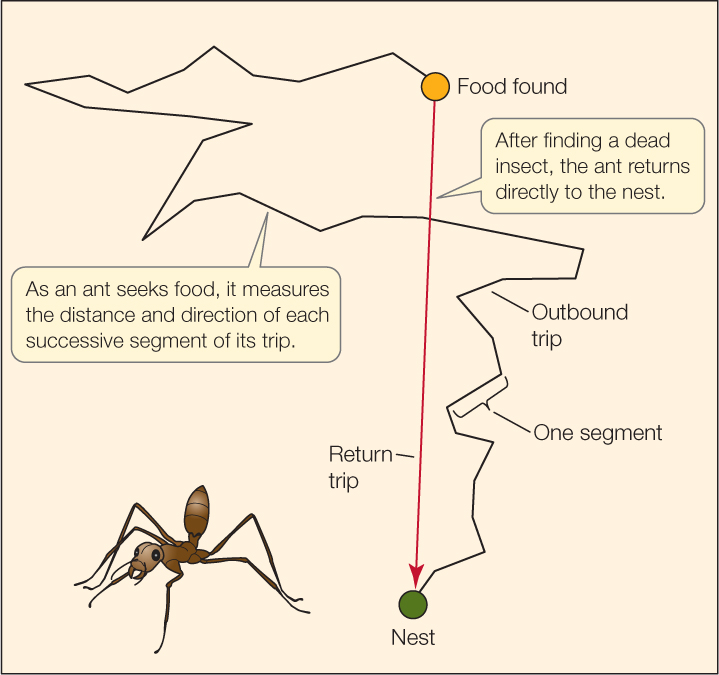
How does a Cataglyphis worker measure the length and direction of each segment of its foraging path? It measures the length of each segment by counting steps (FIGURE 40.9). It can determine the direction by several means, as we will soon discuss.
Investigation
HYPOTHESIS
Desert ants measure distance by keeping track of the number of steps they take.
METHOD
- Train ants to walk from their nest to a feeder 10 meters away and then back to their nest.
- Capture trained ants that have walked from the nest to the feeder and modify them before they start back to their nest. Separate them into three groups, with 25 ants in each group. Shorten the legs of one group (“Stumps”) by removing their lower leg segments. Lengthen the legs of another group (“Stilts”) by gluing pig bristle extensions to their legs. Leave the legs of the third group (“Normal”) unchanged as a control.
- Release the ants at the feeder, so that they can return to their nest. Measure how far they walk before they stop to search for the nest entrance (indicating that they’ve arrived where they expect the nest to be).
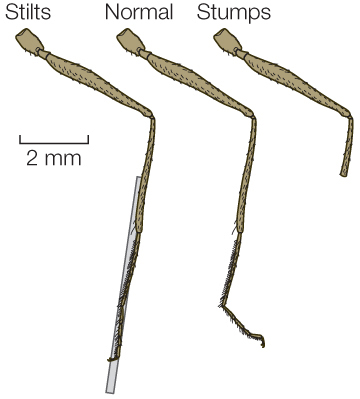
RESULTS

CONCLUSION
Desert ants behave as if they keep track of how far they travel by “counting” their steps.
ANALYZE THE DATA
In a second experiment, the same groups of ants (which had altered legs) were allowed to walk from their nest to the feeder on their altered legs and then return to their nest. The graph shows the distances the three groups of ants walked to get back to their nest.
- How do these results differ from those obtained in the first experiment? Explain why they differ.
- Why is this experiment an important control?
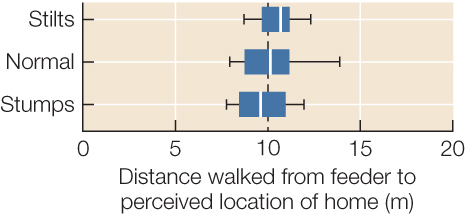
Go to LaunchPad for discussion and relevant links for all INVESTIGATION figures.
aM. Wittlinger et al. 2006. Science 312: 1965–1967.
bThe data are shown as a box plot. The vertical line inside the box is the median, the box indicates the middle 50% of the data, and the horizontal line that extends outside the box indicates the middle 90% of the data.
Animals have multiple ways of determining direction
Much of the earliest research on animal orientation focused on homing pigeons. These pigeons fly back to their home nests even after having been transported tens of kilometers away. For instance, during both World Wars, homing pigeons were extensively used to carry messages. They were reared in home nests near command centers. They then were carried into battle and released with critical messages that they transported back to the command centers.
836
How can homing pigeons determine direction so they can fly home? One mechanism they use is a sun compass. They do not possess a physical compass. We say they have a sun compass because, in essence, they can determine where north, south, east, and west are by observing the sun. To understand the challenge of using the sun as a compass, suppose for a moment that you have no way to know the time of day and that you are suddenly dropped at an unfamiliar location. Suppose also that you see the sun just above the horizon. With the sun in that position, you would reason that when you face the sun, you are facing either east or west. Without knowing the time of day, however, you would not know which: east or west? From thought exercises like this, researchers hypothesized that when pigeons use the sun as a compass, the birds not only must observe the position of the sun but also must know the time of day so that they can calculate compass directions—north, south, east, and west—from the sun’s position. The researchers hypothesized that pigeons use their circadian clock (see Concept 29.6) to provide the necessary information on time of day.
To test this hypothesis, the researchers (working in the Northern Hemisphere) released homing pigeons at a place from which the birds needed to fly south to return home. Think now about the compass position of the sun as it crosses the sky each day. (You can determine the sun’s compass position by dropping an imaginary vertical line from the sun to the horizon and noting where the line intersects the horizon between east and west). The sun is in the east at sunrise, southeast at midmorning, south at noon, southwest at midafternoon, and west at sunset (FIGURE 40.10). Regardless of the time of day when pigeons were released, they tended to fly south. As shown in Figure 40.10A, in midmorning they flew at angle α to the right of the sun’s position. Later in the day, in midafternoon, they flew at angle β to the left of the sun’s position.


Go to ANIMATED TUTORIAL 40.1 Time-Compensated Solar Compass
PoL2e.com/at40.1
The pigeons were then placed in rooms where the lights were turned on 6 hours before sunrise and turned off 6 hours before sunset. After 2 weeks or so, their circadian clocks became entrained (see Concept 29.6) to the artificial light cycle. When the birds were then taken outdoors again and tested for their ability to return home, they did not fly south. For example, when released in midmorning, they flew east! This result provided strong evidence that the birds were using their circadian clocks to determine compass directions from the sun’s position. In midmorning, the time-shifted birds thought the time was midafternoon because their internal clocks had been artificially reset. They flew at angle β to the left of the sun’s position, traveling east (see Figure 40.10B).
By now, a wide variety of animals have been shown to have a sun compass. In most cases, their circadian clocks play an essential role.
Redundancy in mechanisms of orientation was one of the great discoveries to come from the early study of homing pigeons. Investigators found that instead of having a single orientation mechanism, the pigeons have multiple mechanisms. We now know that this sort of redundancy is observed often in the animal kingdom. Homing pigeons are able to find home on cloudy days when they cannot see the sun. A key orientation method they use on cloudy days is to detect Earth’s magnetic field and orient to it. Homing pigeons also sometimes use landmarks such as hills to orient, and they may use odors, low-frequency environmental sounds, and learning from other pigeons.

Go to ANIMATED TUTORIAL 40.2 Homing Simulation
PoL2e.com/at40.2
Many insects and birds are able to determine compass directions by detecting patterns of polarized light in the sky. This mechanism is particularly common in insects, where it depends on specialized photoreceptors. The atmosphere is filled with tiny particles, such as dust, water droplets, and ice crystals. When sunlight strikes such particles, the reflected light rays become polarized, or aligned parallel to one another, to some degree, giving rise to polarization patterns. These patterns are present even if there are only small patches of clear sky. For this reason, the “polarization compass” is often functional on cloudy days.
837
We discussed earlier how Cataglyphis ants in the desert employ path integration by measuring the distances and directions of all segments of a trip they make away from their nest. If a prominent landmark is present, the ants determine their direction of travel relative to the landmark. However, they function perfectly well without any landmarks. Under those circumstances the principal mechanism they use to determine direction is a compass based on polarized light detection. They also have a sun compass.
Birds that migrate at night can use the stars to determine their directions of travel (see Figure 40.5). A great many animals besides birds are now known to be able to orient by using Earth’s magnetic field.
Honey bee workers communicate distance and direction by a waggle dance
Honey bees, like ants, live in colonies in which worker individuals perform services for the colony as a whole. When a worker bee goes on a foraging flight to gather food and finds flowers containing pollen and nectar, she returns to the hive and communicates her discovery to other workers by a specialized behavior called the waggle dance. During her foraging flight, she measures the distance and direction to the flowers. Her dance communicates both of those pieces of information to the other workers so that they also can fly to the flowers.
A bee that discovers a new patch of flowers measures the distance to the patch by monitoring the rate at which she flies past local landmarks (she measures this rate visually). To measure the direction to the flower patch, she monitors the angle of her flight relative to the compass position of the sun. Of course, as she measures these critical pieces of information, she is flying horizontally outdoors. After she returns to the hive, she performs her waggle dance on vertical honeycomb surfaces inside the hive, where it is dark and the sun cannot be seen. The marvel of the waggle dance is that it communicates the information on horizontal distance and angle to the sun while the bee is running (“dancing”) on vertical surfaces in the dark.
During the dance, the bee moves in a repeating figure-eight pattern. She alternates half-circles to the left and right with a short, straight run between each half-circle (FIGURE 40.11). During each straight run, she waggles her abdomen. The duration of the straight, waggle run communicates the distance to the food source. The angle of the straight run relative to vertical communicates the direction to the food source. That angle matches the angle a bee needs to fly relative to the sun’s compass position to find the food source. What happens if the sun is hidden by clouds? Honey bees can infer the position of the sun from atmospheric polarization patterns.
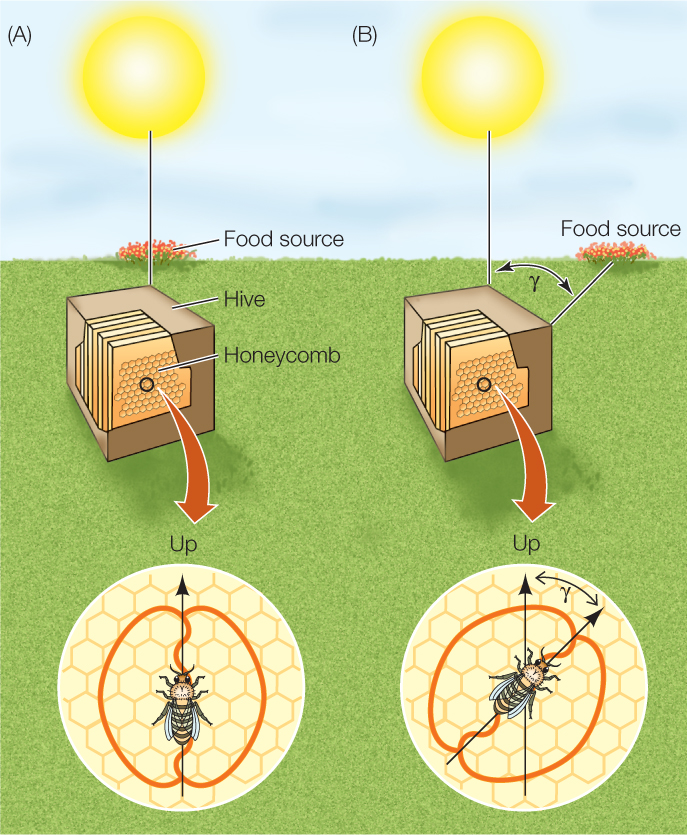
Go to ACTIVITY 40.1 Honey Bee Dance Communication
PoL2e.com/ac40.1
Migration: Many animals have evolved periodic movements between locations
Today biologists are better able to track moving animals than ever before, because of technological innovations. Consequently, a revolution is underway in our understanding of migrations. For example, natural historians have long known that shorebirds called bar-tailed godwits (Limosa lapponica) spend their summers in Alaska and winters in New Zealand:
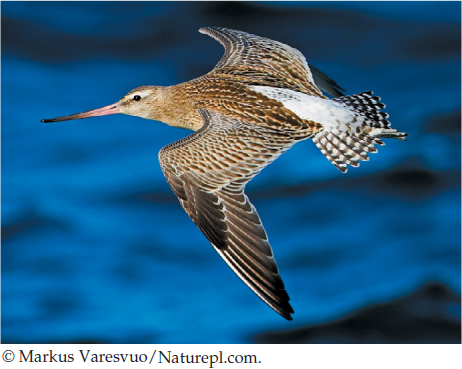
838
Some of the mind-boggling details of their migrations could not be known, however, until individual birds could be outfitted with miniaturized electronics to track their flights. Researchers have just discovered that when the birds leave Alaska, they fly nonstop to New Zealand over the open water of the central Pacific Ocean—a trip of more than 10,000 kilometers. For the 6–9 days of the trip, the birds cannot eat or drink. They presumably do not sleep. Their flight muscles must engage in powering or controlling flight continuously day and night—not to mention the necessity of navigating accurately over endless expanses of water. As often happens in the practice of science, the tracking studies of godwits seem to raise more questions than they answer.
Specialists vary in the way they define migration. A useful general definition is that animals migrate when they periodically move from one location to a different location, remain for a substantial length of time, and later return.
One of the long-distance migrations that is currently best understood is that of young loggerhead sea turtles (Caretta caretta). Several decades ago, Archie Carr coined the term “the missing year” in describing these turtles, which hatch out of eggs on beaches in places such as Florida. For a while, the little turtles can be found in the ocean along the Florida coast, but then they disappear. The next time they are seen, about a year later, they are much bigger. Where have they been during their missing year, and how did they find their way back?
Recent genetic studies have been crucial for determining where the turtles go. The turtles that hatch in a particular region of Florida display a distinctive genetic signature in terms of allele frequencies. Researchers discovered that turtles in the ocean west of Africa have the same signature. This and other evidence indicate that after hatching in Florida, young loggerhead sea turtles migrate across the Atlantic Ocean to African waters. Then, growing as they go, they migrate back to the waters off Florida. The turtles do not need to power their migration entirely by swimming because a large circular water current (the North Atlantic Subtropical Gyre) helps them travel all along the way. As shown in FIGURE 40.12, the turtles use Earth’s magnetic field to help them complete their journey and ensure that they do not get lost at sea. The tan circles in the figure show the results of experiments demonstrating that the turtles are able to orient their direction of swimming in relation to magnetic fields so that they stay in the circular water current.
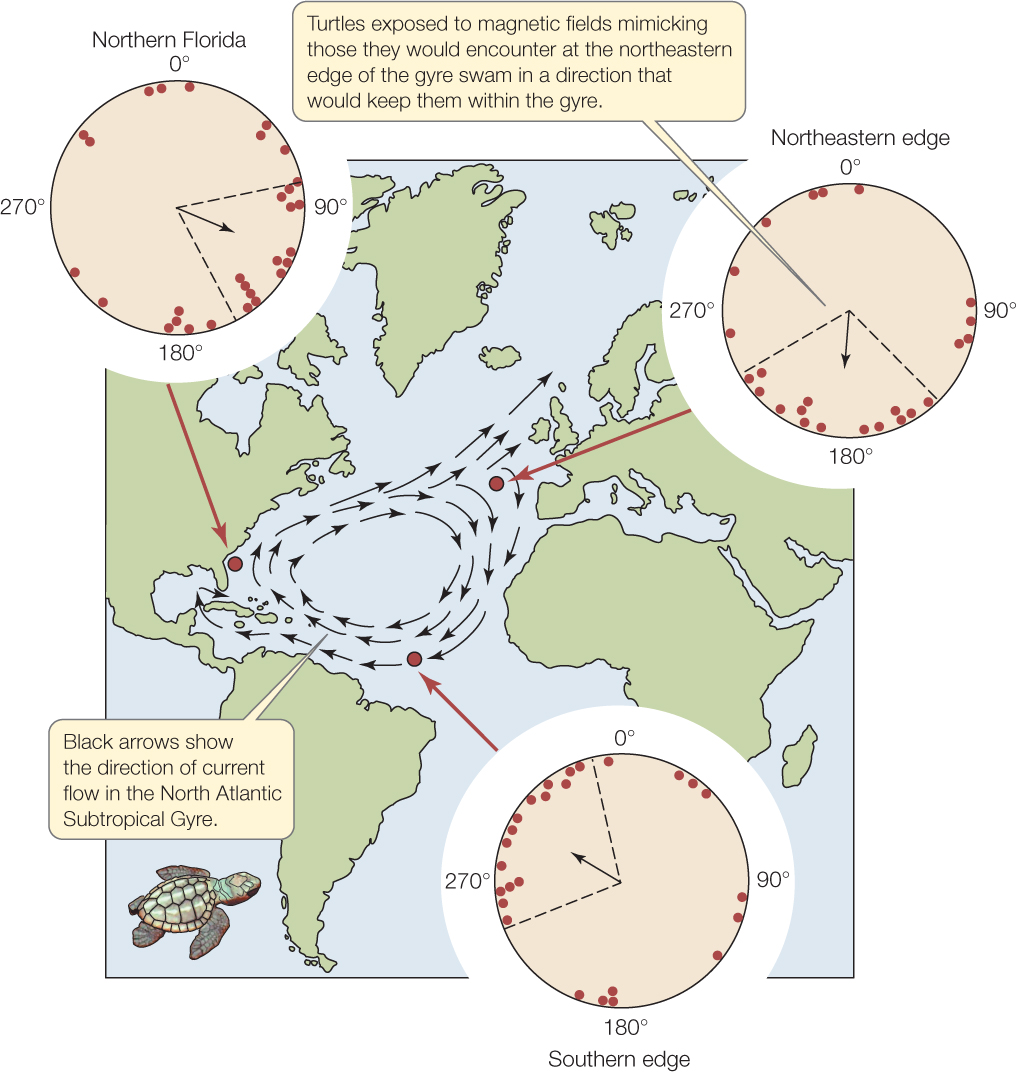
CHECKpoint CONCEPT 40.4
- Why is an accurate circadian clock crucial to the sun compass method of orientation?
- In some species of ants, when workers employ a trail pheromone to mark a trail to a food source, each worker that goes to the food source adds more pheromone to the trail on its way home if it readily found food at the source. How could this process act as a positive feedback loop to draw large numbers of workers to a distinctively valuable food source?
- Why might natural selection favor the emergence of redundant methods of orientation?
Now we will turn to one of the themes with which we began this chapter, namely that animals often do not function alone. When animals interact with each other, behavior is the paramount way in which they do so.
839